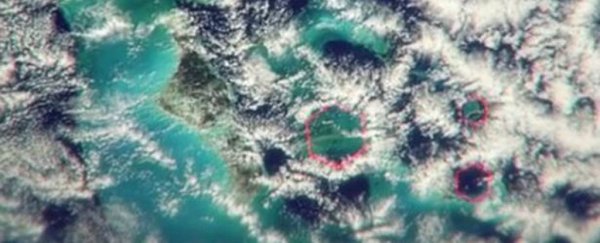A story has gone viral this morning claiming that experts have finally 'solved' the Bermuda Triangle mystery, with the discovery of strange, hexagonal-shaped clouds covering the region.
According to a new Science Channel documentary on the issue, these hexagonal clouds are creating winds of 106 kilometres per hour (65 mph) that act as "air bombs" to sink ships and bring down planes.
But there's one problem - the Bermuda Triangle actually doesn't exist, and there is no 'mystery' to solve. There are actually no extra unexplained plane crashes and shipwrecks in the area, despite what you might have heard.
The name Bermuda Triangle refers to a region of ocean bordered by Florida, Bermuda, and Puerto Rico, and it was first brought to public attention back in the 1950s by a journalist named Edward Van Winkle Jones, who wrote a story for the Associated Press about a large number of ships and planes that had disappeared in the region.
The idea really took off in the 1970s, when Charles Berlitz published the best-selling The Bermuda Triangle, and everyone started speculating about UFOs or rogue waves that were frequenting the region.
But the problem was, no one had actually fact-checked the claims of boats and planes going missing in the first place. And when journalist Larry Kusche actually did a few years later, he discovered there was actually no mystery to solve in the first place.
The 'mysterious disappearances' everyone was freaking out over were either reporting mistakes or outright fabrications.
As Benjamin Radford explains for Live Science:
"In some cases there's no record of the ships and planes claimed to have been lost in the aquatic triangular graveyard; they never existed outside of a writer's imagination. In other cases, the ships and planes were real enough – but Berlitz and others neglected to mention that they 'mysteriously disappeared' during bad storms. Other times the vessels sank far outside the Bermuda Triangle."
There are some real boats and ships that have gone missing in the region, but seeing as it's one that's frequented by tankers, cruise ships, charter planes, and small pleasure ships – as well as the location of hurricane alley and the notorious Gulf Stream, that's not all that surprising.
Kusche published a book on the subject, The Bermuda Triangle Mystery - Solved, in 1975, but despite converting a few former believers, the myth of the Bermuda Triangle remained.
Which brings us back to today, and this new 'breakthrough' in the Bermuda Triangle case.
Researchers have now analysed imagery from a NASA satellite and spotted hexagonal-shaped clouds ranging between 32 and 88 kilometres (20 and 54 miles) wide, roughly around 240 kilometres (149 miles) off the coast of Florida, over the Bahamas.
Steve Miller, a satellite meteorologist from Colorado State University, told the Science Channel that their straight-edged appearance is pretty unusual.
"You don't typically see straight edges with clouds," said Miller. "Most of the time clouds are random in their distribution."
Although they can't be that uncommon, because the team also examined similar cloud shapes over the North Sea off the coast of the UK and found them associated with sea level winds of up to 160 kilometres per hour (99 miles per hour), which are powerful enough to create waves more than 14 metres (45 feet) high.
"These types of hexagonal shapes over the ocean are in essence air bombs," Randy Cerveny from the University of Arizona told the Science channel.
"They are formed by what are called microbursts and they're blasts of air that come down out of the bottom of a cloud and then hit the ocean and then create waves that can sometimes be massive in size and they start to interact with each other."
None of this insight into the clouds has been published in a peer-reviewed journal as yet, so let's take it with a grain of salt.
But it's entirely possible that hexagonal clouds could be common over the region, and they could be associated with stronger-than-normal winds.
Still, that doesn't change the fact that there isn't a strange excess of disappearances in the region to solve in the first place. So the real news here isn't the solution to a long-standing myth, it's potential evidence of a new weather phenomenon, and that's pretty cool in itself.
